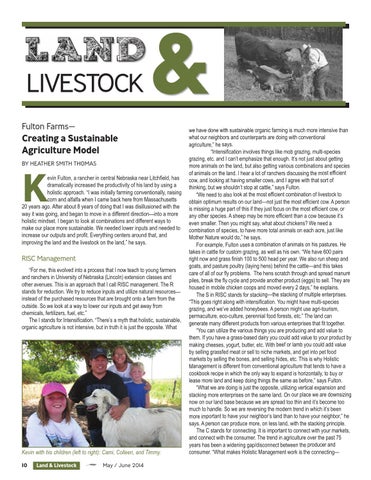LIVESTOCK
&
Fulton Farms—
Creating a Sustainable Agriculture Model BY HEATHER SMITH THOMAS
evin Fulton, a rancher in central Nebraska near Litchfield, has dramatically increased the productivity of his land by using a holistic approach. “I was initially farming conventionally, raising corn and alfalfa when I came back here from Massachusetts 20 years ago. After about 8 years of doing that I was disillusioned with the way it was going, and began to move in a different direction—into a more holistic mindset. I began to look at combinations and different ways to make our place more sustainable. We needed lower inputs and needed to increase our outputs and profit. Everything centers around that, and improving the land and the livestock on the land,” he says.
K
RISC Management
“For me, this evolved into a process that I now teach to young farmers and ranchers in University of Nebraska (Lincoln) extension classes and other avenues. This is an approach that I call RISC management. The R stands for reduction. We try to reduce inputs and utilize natural resources— instead of the purchased resources that are brought onto a farm from the outside. So we look at a way to lower our inputs and get away from chemicals, fertilizers, fuel, etc.” The I stands for Intensification. “There’s a myth that holistic, sustainable, organic agriculture is not intensive, but in truth it is just the opposite. What
Kevin with his children (left to right): Cami, Colleen, and Timmy. 10
Land & Livestock
May / June 2014
we have done with sustainable organic farming is much more intensive than what our neighbors and counterparts are doing with conventional agriculture,” he says. “Intensification involves things like mob grazing, multi-species grazing, etc. and I can’t emphasize that enough. It’s not just about getting more animals on the land, but also getting various combinations and species of animals on the land. I hear a lot of ranchers discussing the most efficient cow, and looking at having smaller cows, and I agree with that sort of thinking, but we shouldn’t stop at cattle,” says Fulton. “We need to also look at the most efficient combination of livestock to obtain optimum results on our land—not just the most efficient cow. A person is missing a huge part of this if they just focus on the most efficient cow, or any other species. A sheep may be more efficient than a cow because it’s even smaller. Then you might say, what about chickens? We need a combination of species, to have more total animals on each acre, just like Mother Nature would do,” he says. For example, Fulton uses a combination of animals on his pastures. He takes in cattle for custom grazing, as well as his own. “We have 600 pairs right now and grass finish 100 to 500 head per year. We also run sheep and goats, and pasture poultry (laying hens) behind the cattle—and this takes care of all of our fly problems. The hens scratch through and spread manure piles, break the fly cycle and provide another product (eggs) to sell. They are housed in mobile chicken coops and moved every 2 days,” he explains. The S in RISC stands for stacking—the stacking of multiple enterprises. “This goes right along with intensification. You might have multi-species grazing, and we’ve added honeybees. A person might use agri-tourism, permaculture, eco-culture, perennial food forests, etc.” The land can generate many different products from various enterprises that fit together. “You can utilize the various things you are producing and add value to them. If you have a grass-based dairy you could add value to your product by making cheeses, yogurt, butter, etc. With beef or lamb you could add value by selling grassfed meat or sell to niche markets, and get into pet food markets by selling the bones, and selling hides, etc. This is why Holistic Management is different from conventional agriculture that tends to have a cookbook recipe in which the only way to expand is horizontally, to buy or lease more land and keep doing things the same as before,” says Fulton. “What we are doing is just the opposite, utilizing vertical expansion and stacking more enterprises on the same land. On our place we are downsizing now on our land base because we are spread too thin and it’s become too much to handle. So we are reversing the modern trend in which it’s been more important to have your neighbor’s land than to have your neighbor,” he says. A person can produce more, on less land, with the stacking principle. The C stands for connecting. It is important to connect with your markets, and connect with the consumer. The trend in agriculture over the past 75 years has been a widening gap/disconnect between the producer and consumer. “What makes Holistic Management work is the connecting—
